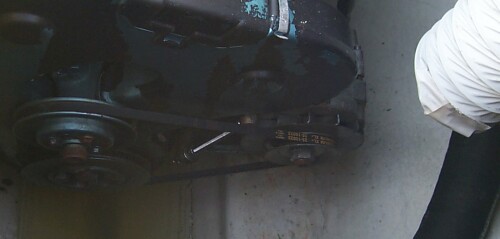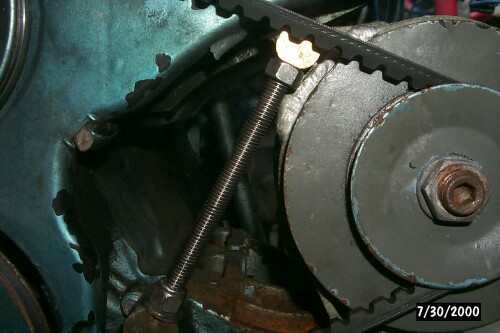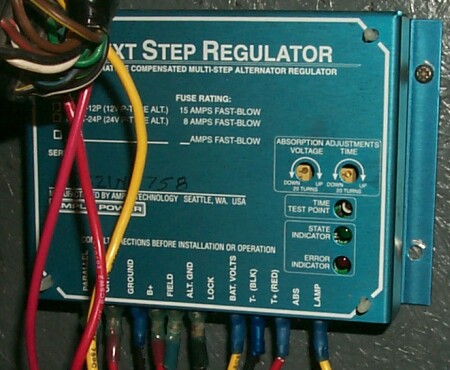Increasing the Power Supply
With the installation of the Link 20 battery monitor in 1997 we became aware just how under-powered the charging system was on our Prout Escale. Hours of engine time translated into relatively little charge. Subsequent review of the Perkins OEM specs revealed that the alternator on the engine was good enough for a starter battery and little else (40A max, primitive internal regulation, etc.). So, if we wanted to keep our batteries topped up we had no choice but to upgrade the charging system.
On the one hand I want to berate Prout Catamarans for not installing a better charging system on a sailboat meant for cruising. On the other hand, given Prout Catamarans' levels of electrical competence, maybe it is better that we did it ourselves. A recent new 38' owner couple had a complete electrical meltdown after the batteries in their system were fried by being overcharged!

We replaced the Perkins alternator with a custom-fit charging system from Ample Power, which has been great. The temperature compensated charging cycle is incredibly powerful, putting up to 50+ amps back into the system at idle, over 100 amps while running hard. The alternator above is being cooled by 125 CFM of air from one of our Attwood 4000 blowers coming out of the tubing you can see to the right. I heartily recommend Ample Power to anyone that is looking for a very powerful retrofit system.
We had a number of minor issues installing the Ample Power system. The most obvious was the non-standard foot on our Perkins diesel. Ample Power was kind enough to move the "foot" on their alternator to accommodate our engine at no charge. It required them to grind off the foot and re-weld it in a new location - not a simple change. Thank you!
As the OEM alternator was somewhat smaller in OD than the Ample Power unit, it no longer fit neatly into a fold of the engine. However, we saw this as an opportunity to create a new tensioner mechanism that does not rely on the traditional friction plate set-up used on most alternators today. Rather, it consists a stainless threaded rod with brass ends and locking hex nuts. This allows us to dial in the exact pressure we want and the tensioner does not budge from that position. I think this is a much better solution than the friction plate, particularly as one does not rely on the crowbar approach to get the alternator to the right tension in the first place.
While the alternator is not as snug to the body of the engine as originally conceived, I don't think this is much of a problem. In fact, it may help the alternator to cool better by directing airflow around the whole body of the alternator. The really observant among you would notice that this is the Perkins pulley wheel on the alternator. We transferred that to the Ample Power alternator because it allowed better alignment of the pulley wheels. I never knew how important alignment is until we were shredding pulley belts!

Upon installation of the Ample Power alternator, the engine would no longer start properly. While the starter would churn the engine, the engine would not start running on its own. The culprit was the fast tachometer response of the Ample Power alternator and the starter relays in the Perkins grounded to the tachometer. The original intention was to prevent people from "starting" an already running engine although it seemed somewhat redundant since the starter has a similar interlock built into it.
Furthermore, there is little question when our engine is running as we practically stand on top of it. Once we grounded the relay wire, the engine started beautifully, as usual. I did manage to chew through a number of belts until we had the pulleys exactly parallel. Now we get a long belt life (I prefer top of the line Gates belts) and a powerful charge.
Here you can see a picture of the external regulator. The instructions for the Next Step Regulator are very clear and installation was easy. This regulator is good for single or dual engine installs and a bargain given its excellent 3-step charging performance. I was almost giddy motoring out and watching the amps flow back into the batteries. During warm summer days, 1/2 hour of engine runtime gets the batteries back to the absorption stage. When the engine runs longer, the batteries are worked to the float stage. Finally, it was not unusual to have full batteries!

It is best to stick with one company for the regulator and the alternator. If any problems do occur, it is much easier to diagnose a fault and the manufacturer does not gain anything by shifting blame around. I also liked the no-nonsense approach that Ample Power takes to product development and the extensive web-site that carries everything from installation manuals to general 12VDC system advice. Their troubleshooting section requires you to measure a lot up front - but it minimizes time on the phone and the engine later. This is especially helpful for those whose phone is not close to the boat.
Most companies can be measured by their customer service. Ample Power's response when we had a failure was very good. In our case, the alternator had to be replaced the summer after we had installed it. Initially misdiagnosed as a bad regulator (which apparently fail more often than alternators), it turned out to be a shorted rotor. While my warranty card had not made it back to Ample Power, they were able to locate my file, verify the warranty period, and a warranty replacement was on its way that afternoon. What exactly caused our rotor to short out is still a mystery, but the net effect was that my cruising vacation in 1999 was cut short from 7 days to 3. Luckily Brunswick, Maine has an excellent alternator resource in Morins auto parts which had confirmed the bad rotor and swapped it out by special request for the replacement in 15 minutes.
Best Estimate for Time Required:
| Research alternator options | 4 hours |
|---|---|
| Remove Perkins alternator and install modified Ample Power alternator | 2 hours |
| Install new wiring to accommodate charge currents, voltage drop requirements | 2 hours |
| Create custom tensioning system for alternator | 3 hours |
| Test system | 0.5 hours |
| Total | 11.5 hours |
|---|


